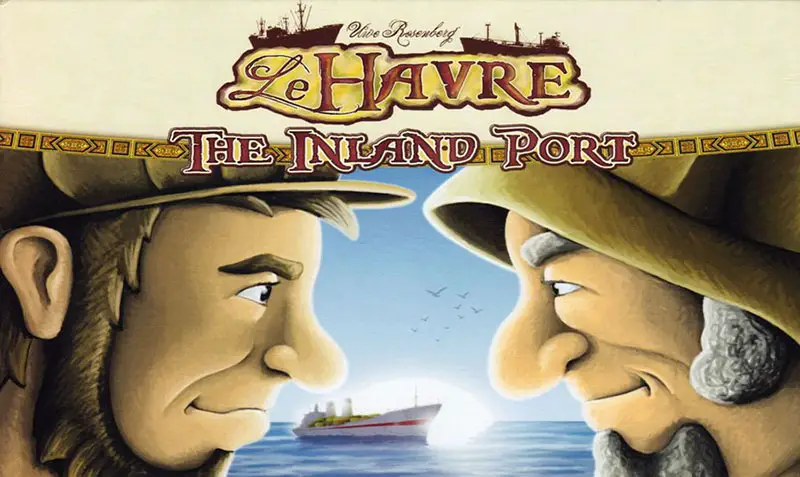
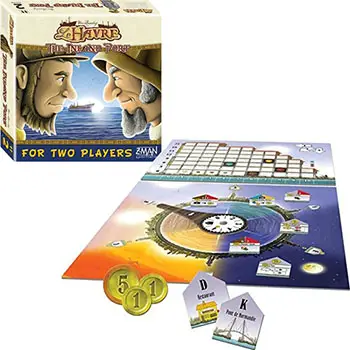
Components
- 2 game boards with pointers
- 2 Warehouse boards
- 31 Building tiles
- 20 "1 Franc" coins
- 10 "5 Francs" coins
- 1 Building overview
- 8 Goods counters
- 8 wooden cubes
- Rulebook
Object of the Game
Le Havre: It is now time to build the city's inland port. The players build and use 31 different buildings while growing their supplies of the 4 types of goods in order to be the richest player at the end of the game.
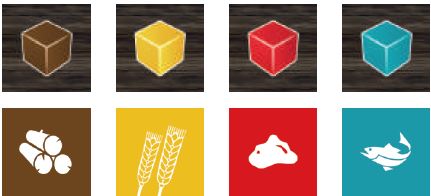
Le Havre - The Inland Port includes three different ways of tracking the goods in your warehouse: the front or the back of the goods counters, or the wooden cubes. Simply use the method you prefer.
Setup
Randomly determine the starting player. This player takes the game board with letters A-F, and the other player takes the game board with letters G-L. Each player also takes a Warehouse board, 4 different goods counters, and 3 Francs.
At the beginning of the game, the pointer on each game board points upwards (towards A or G). Both players put their goods counters on the indicated spaces of their Warehouse board: thus, each player starts the game with 4 Fish (blue), 3 Clay (red), 2 Wood (brown), and 1 Grain (yellow).
Sort the Building tiles by the letters on their backside and set them aside; they enter the game in alphabetical order. Put the Building overview in the middle, so that both players can easily see which buildings enter the game during which phase.
Each game board is divided into 6 sectors. The pointer assigns a value to each sector: 0, 2, 3, 4, 4+ 
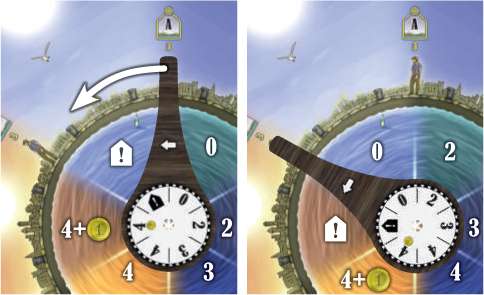
When turning the pointer, the values of each sector changes.
Game Play
The game is played over 12 rounds in which the players take turns carrying out a specific number of actions.
Each round goes through a set number of phases:
Beginning Of The Round: New Buildings Enter Play.
Main phase: Players take turns carrying out a combined number of actions that is equal to the number below the current round letter on the game board.
End of the round: Both players turn their pointers to the next letter in counter-clockwise order. Players may be forced to sell buildings.
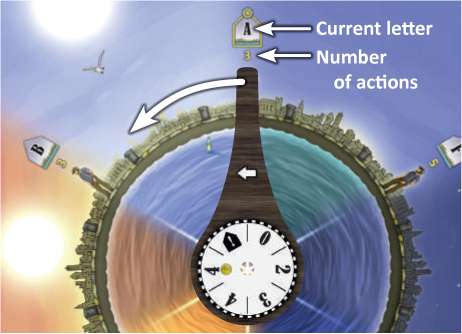
Example:
Emma and Max are playing against each other.
Emma is the starting player. In the first round, the buildings with letter A enter the game. Then, both players carry out a total of three actions - Emma carries out the first one, followed by Max, and finally, Emma takes the last action.
Afterwards, they both turn their pointers to the next letter (Emma turns it to letter B, Max to letter H).The B buildings now enter the game, and Max is the starting player. This round, he will carry out two actions, and Emma only one.
The Buildings
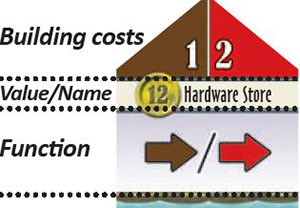
All buildings have the same layout: building costs, value, name, function.
There are three different types of building costs. 21 buildings are paid with a combination of Wood (brown) and/or Clay (red).
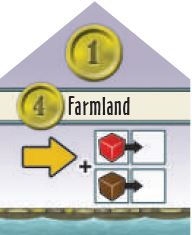
5 buildings require a specific amount of Food (Food is any combination of Fish (blue) and/or Grain (yellow)).
The other 5 buildings are paid for with Francs. If a player does not have the required goods or Francs, he may not build that building.
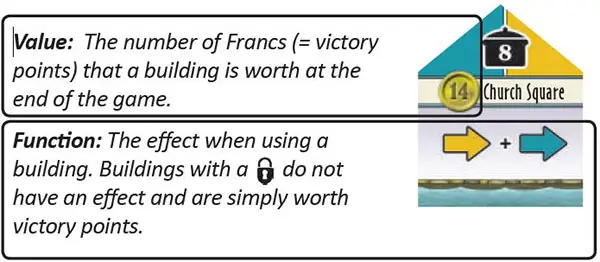
The Phases
Beginning of the Round:
The pointer indicates three things: which buildings enter the game, the number of actions, and the starting player.
All buildings with the current round letter enter the game. Previously introduced buildings stay in play. The number of actions shown is the sum of both players' actions: e. g. a 3 indicates that the starting player will carry out 2 actions, and the other player 1 action.
The number of actions is always an odd number resulting in an alternating starting player. The starting player of each round is also indicated by a light border around the current letter on the game board.
The game rounds follow the alphabet: the first six rounds (A to F) are indicated on the first player board and the last six rounds (G to L) are on the second player board.
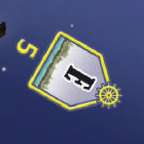
Round E: the E-Buildings come into play; 5 actions will be carried out this round; and this player will be the starting player of that round.
Main Phase
On his turn, a player has two options: he can either build a building, or use an already built one. He must choose one of these two options. In addition to his action, a player may sell one or more of his buildings.
Build
The player takes one of the buildings that are in play, but not yet built, pays its building costs, and puts it on his game board to the RIGHT of the pointer (i.e. in sector 0). Then his turn is over.
Use
The player chooses an already built building and applies its effect a number of times equal to the value of the sector currently occupied by the building. Some buildings have an additional one-time effect. After applying all its effects, the player moves the used building to sector 0. Then his turn is over.
A player is not limited to using his own buildings, he can also use his opponent's. To do so, he must pay his opponent 1 Franc every time he wants to use one of his opponent's buildings (regardless of which sector the building occupies). Afterwards, the building is moved to sector 0 on his opponent's board.
Buildings in sector 0 may not be used under any condition, not even to use its additional one-time effect.
Built buildings may be in one of 5 sectors:
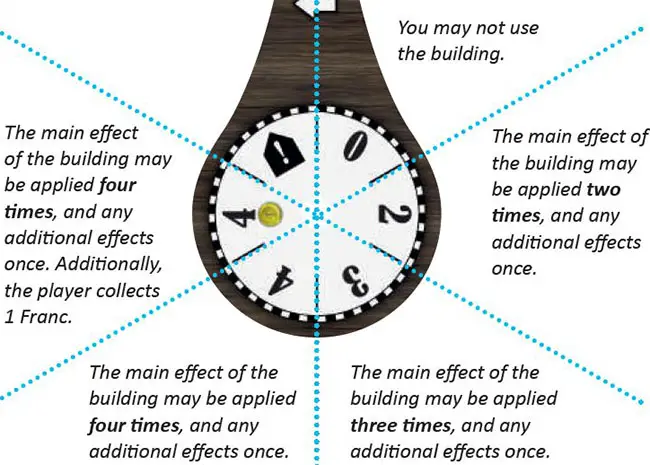
The Meaning of the Symbols
-

Move the red goods counter to the right.
-

Move the brown goods counter diagonally up to the right.
-

Move different goods counters diagonally up to the left.
-

Move any goods counters to the right.
-

Collect X Francs.
-

Move the yellow goods counter exactly one space diagonally down to the left.
-

Move the blue goods counter exactly one space to the right.
-

Pay the costs to the left of the arrow to apply the effect to its right. The costs are paid for each application.
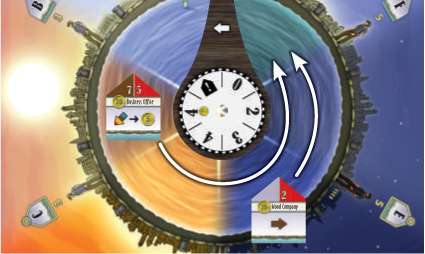
Example: Emma uses the Wood Company in sector 3. She may move the Wood goods counter on her Warehouse board three spaces to the right.

Max wants to use Emma's Business Office in sector 4 @1.jpg+ . He pays Emma 1 Franc and then moves his four goods counters diagonally down to the left and collects 4x5=20 Francs... plus 1 bonus Franc for the sector

Important: A goods counter stops at the last space of a row or column and cannot be moved further than that.
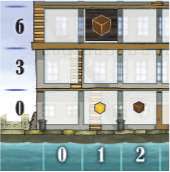
The position of a goods counter indicates the number of goods a player has of its type; add up the values of its row and column.
This player has 7 Wood (6+1).
There are three ways to pay costs:
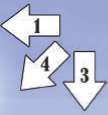
When moving a goods counter to the left, the player is paying 1 unit of the given good. When moving it down, he is paying 3 units. When moving it diagonally down to the left, he is paying 4 units.
There is no "change": if the Wood counter is on the 6 in the second column and the player wants to pay 2 Wood, he will have to overpay as he can only get 2 by moving Wood down (3 per move), and cannot move it twice to the left (1 per move).
Sell
Anytime during his turn, a player may sell his own buildings in addition to his action. If he does so, he collects half the building's value in Francs. Sold buildings may be built again by both players.
End of the Round
A round ends after all actions for that round have been carried out. This is easily traceable as each action results in a building being moved to sector 0.
Afterwards, both players turn their pointer one sector in counter-clockwise order (i.e. in the direction of the arrow).
At this point, if there are any buildings in sector  , they must be sold immediately for half their value. Play proceeds with the next round.
, they must be sold immediately for half their value. Play proceeds with the next round.
The game ends at the end of the 12th round
End of the Game
The game ends after turning the pointer at the end of round L. This may result in a final forced sale of buildings.
Then, both players add up the values of their buildings and their leftover Francs. The player with the highest total wins the game.
In case of a tie, play one more game, making sure that you play with the other board (thus, the player with the G-L board will now have the A-F board).
Building Index
-
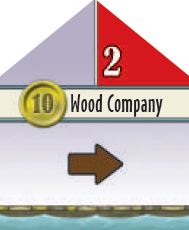
Wood Company
Move the Wood goo ds counter 2-4 spaces to the right according to the position of the Wood Company.
-
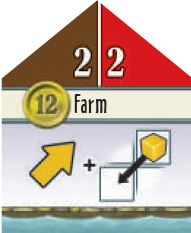
Farm
Move the Grain goods counter 2-4 spaces diagonally up to the right according to the position of the Farm. Additionally, move Grain 1 space diagonally down to the left.
Apply both against each other. Consequently, Grain is in reality moved 1-3 spaces diagonally up to the right
-
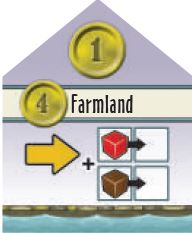
Farmland
Move the Grain goods counter 2-4 spaces to the right according to the position of the Farmland.
Additionally, move both Wood and Clay 1 space each to the right.
-
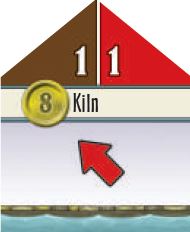
Kiln
Move the Clay goods counter 2-4 spaces diagonally up to the left according to the position of the Kiln.
-
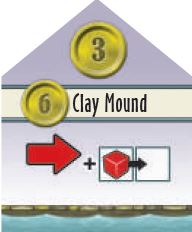
Clay Mound
Move the Clay goods counter 2-4 spaces to the right according to the position of the Clay Mound.
Additionally, move Clay 1 more space to the right
-
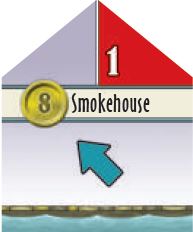
Smoke House
Move the Fish goods counter 2-4 spaces diagonally up to the left according to the position of the Smokehouse.
-
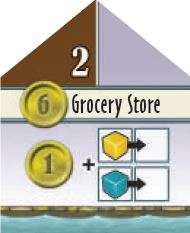
Grocery Store
Collect 2-4 Francs according to the position of the Grocery Store.
(Collect 5 Francs if the Grocery Store is in sector 4 +
 ). Additionally, move both Grain and Fish 1 space each to the right.
). Additionally, move both Grain and Fish 1 space each to the right. -
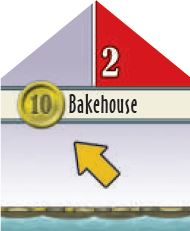
Bakehouse
Move the Grain goods counter 2-4 spaces diagonally up to the left according to the position of the Bakehouse.
-
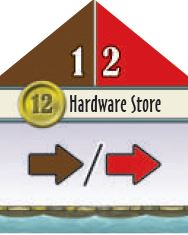
Hardware Store
Move either Wood or Clay 2-4 spaces to the right according to the position of the Hardware Store. You may not distribute the 2-4 spaces among Wood and Clay.
-
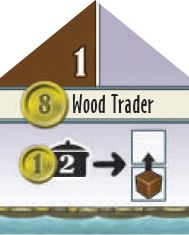
Wood Trader
If the Wood Trader is in sector 2, you may pay 1 Franc and 2 Food to move Wood 1 space up (you can pay twice to do this 2 times).
In sector 3, 4, or 4+
 , you may do this 3 or 4 times accordingly, paying the cost each time. You may apply the 1 Franc you get in sector "4+
, you may do this 3 or 4 times accordingly, paying the cost each time. You may apply the 1 Franc you get in sector "4+  " against the costs.
" against the costs. -
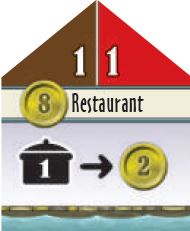
Restaurant
If the Restaurant is in sector 2, you may sell 1 Food for 2 Francs (you can sell Food twice to do this 2 times).
In sector 3, 4, or 4 +
 , you may do this 3 or 4 times accordingly, selling one Food each time.
, you may do this 3 or 4 times accordingly, selling one Food each time. -
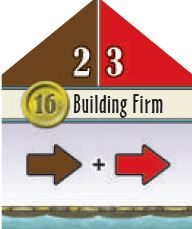
Building Firm
Move both Wood and Clay 2-4 spaces to the right according to the position of the Building Firm.
-
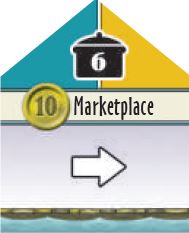
Marketplace:
Move any 2-4 goods counters 1 space to the right according to the position of the Marketplace. You may move the same goods counter multiple times.
Alternatively, you may also distribute the spaces among any number of goods counters.
-
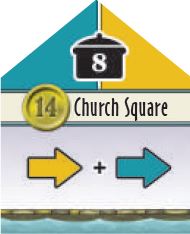
Church Square
Move both Grain and Fish 2-4 spaces to the right according to the position of the Church Square.
-
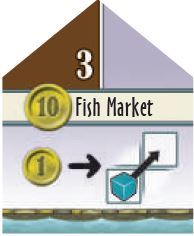
Fish Market
If the Fish Market is in sector 2, you may pay 1 Franc to move Fish 1 space diagonally up to the right (you can pay twice to do this 2 times).
In sector 3, 4, or 4 +
 , you may do this 3 or 4 times accordingly, paying the cost each time. You may apply the 1 Franc you get in sector 4+
, you may do this 3 or 4 times accordingly, paying the cost each time. You may apply the 1 Franc you get in sector 4+ against the costs.
against the costs. -
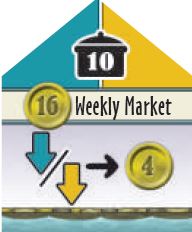
Weekly Market
If the Weekly Market is in sector 2, you may move Grain or Fish 1 space down to collect 4 Francs (you can move down twice to do this 2 times).
In sector 3, 4, or 4 +
 , you may do this 3 or 4 times accordingly, paying the cost each time.
, you may do this 3 or 4 times accordingly, paying the cost each time. -
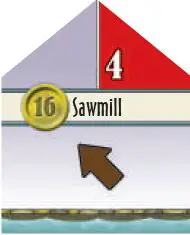
Sawmill
Move the Wood goods counter 2-4 spaces diagonally up to the left according to the position of the Sawmill.
-
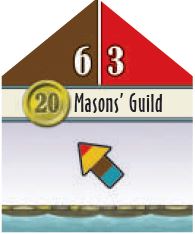
Masons' Guild
Move 2-4 different goods counters 1 space diagonally up in the left according to the position of the Masons' Guild. You may not move the same goods counter more than 1 space.
-
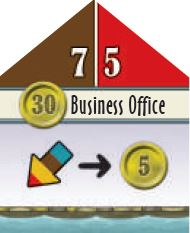
Business Office
Move 2-4 different goods counters 1 space diagonally down to the left according to the position of the Business Office.
Collect 5 Francs per movement. You may not move the same goods counter more than 1 space.
-
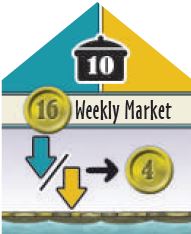
Craftsmen's Yard
Move any 2-4 goods counters 1 space diagonally up to the left according to the position of the Craftsmen's Yard. Additionally, move 1 more goods counter 1 space diagonally up to the left.
You may move the same goods counter multiple times. Alternatively, you may also distribute the spaces among any number of goods counters.
-
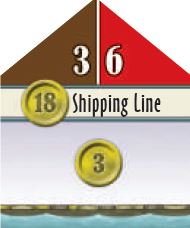
Shipping Line
Collect 6, 9, or 1 2 Francs according to the position of the Shipping Line.
(Collect 1 more
 in sector 4 +
in sector 4 +  ).
). -
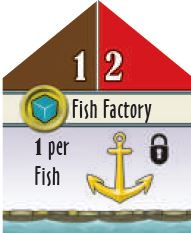
Fish Factory
At the end of the game, the Fish Factory is worth
 per Fish in your warehouse.
per Fish in your warehouse.The
 symbol indicates that this building may increase the value of the Dock.
symbol indicates that this building may increase the value of the Dock. -
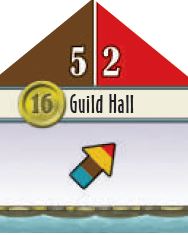
Guild Hall
Move 2-4 different goods counters 1 space diagonally up to the right according to the position of the Guild Hall.
You may not move the same goods counter more than 1 space.
-
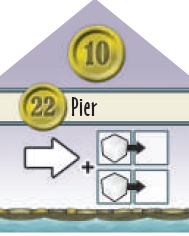
Pier
Move any 2-4 goods counters 1 space to the right according to the position of the Pier. Additionally, move 2 more goods counters 1 space to the right.
You may move the same goods counter multiple times. Alternatively, you may also distribute the spaces among any number of goods counters.
-
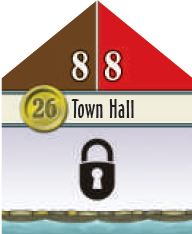
Town Hall
The Town Hall has no effect.
It is worth 26 victory points at the end of the game.
-
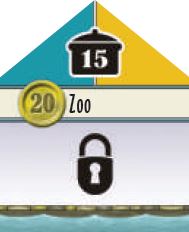
Zoo
The Zoo has no effect.
It is worth 20 victory points at the end of the game.
-
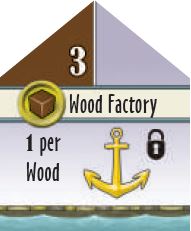
Wood Factory
At the end of the game, the Wood Factory is worth
 per Wood in your warehouse.
per Wood in your warehouse.The
 symbol indicates that this building may increase the value of the Dock.
symbol indicates that this building may increase the value of the Dock. -
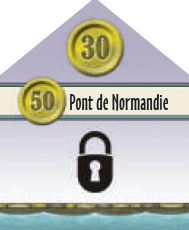
Pont De Normandie
The Pont de Normandie has no effect.
It is worth 50 victory points at the end of the game.
-
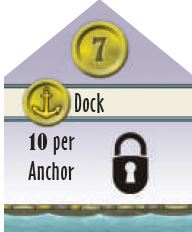
Dock
At the end of the game, the Dock is worth
 per
per  building you have built.
building you have built. -
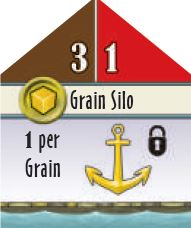
Grain Silo
At the end of the game, the Grain Silo is worth
 per Grain in your warehouse.
per Grain in your warehouse.The
 symbol indicates that this building may increase the value of the Dock.
symbol indicates that this building may increase the value of the Dock. -
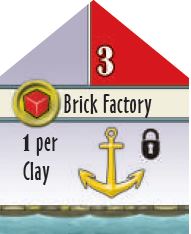
Brick Factory
At the end of the game, the Brick Factory is worth
 per Clay in your warehouse.
per Clay in your warehouse.The
 symbol indicates that this building may increase the value of the Dock.
symbol indicates that this building may increase the value of the Dock.
Continue Reading

